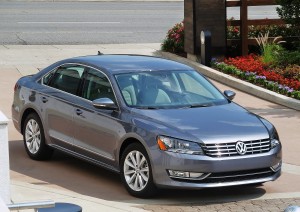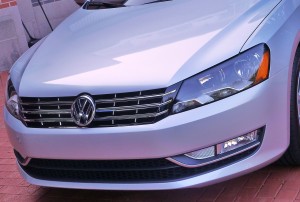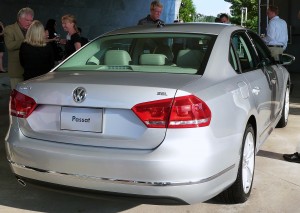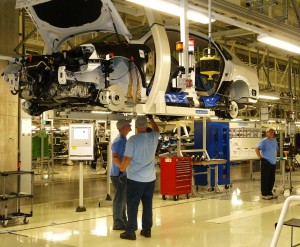U.S.-only Passat challenges midsize icons
By John Gilbert
It might seem logical for comparison shoppers evaluating the highly-competitive midsize segment to find themselves drawn to the Volkswagen Passat.
But that’s not fair, you say, because the Passat, with its German engineering, is more substantial and more expensive than others in the midsize segment. Aha, but that’s a perception that is both true and false, when it comes to the newly redesigned 2012 Passat.
The 2012 Passat looks entirely different as it jumps with all four wheels into the thick of the midsize cluster in size and price, while retaining its proven engines, highest-tech direct-sequential transmissions, lengthy list of standard equipment, and the solid feel of German engineering — with a couple other significant new twists.The new Passat is designed specifically for United States consumers, and will be built in an all-new plant in Chattanooga, Tenn.
Volkswagen’s adjusted product strategy means its slightly enlarged Passat is designed for U.S. buyers, and built in the U.S. at the all-new VW factory in Chattanooga. Compressing the price structure allows the Passat to take dead-aim at the midsize stalwarts from Asia, such as Toyota Camry, Honda Accord, Nissan Altima, and the onrushing Korean pair of Hyundai Sonata and Kia Optima, plus the rejuvenated domestic products such as Chevrolet Malibu and Ford Fusion. All of those are impressive for various reasons, although some of them may have gone to seed out of corporate complacency, which leaves plenty of opening for the new Passat.
Restyling of the Passat couldn’t have come at a better time. The once-distinctive sedan had become pretty anonymous and almost invisible over the years, both figuratively and literally, although it was still a good and solid sedan. Looking back over the last decade, VW sold 80,000 Passats here in 2001, but that number fell off and has dwindled to about 12,000 now, making it an outsider in a segment that has expanded and grown at a record rate. Maybe Volkswagen grew comfortable depending on the smaller Golf and Jetta to carry the load, and didn’t mind if buyers perceived the Passat as being upscale, rising above the fray. But the real action is within the fray, and that’s where VW intends the new Passat to be.
As the midsize segment heads toward an anticipated 2.9 million, VW’s strategy to challenge the best competitors with a thoroughly refreshed weapon. Before conquering the world, Volkswagen will gladly settle for returning to its previous popularity in the U.S., with the new Passat leading its market-share charge. The gamble is that a nameplate that has fallen to 12,000 annual sales will now come from a new facility that can build as many as 150,000 Passats per year.
Kevin Joostema, VW’s manager of product marketing strategy, put it pretty directly when he said: “If we can’t make a midsize sedan right, it would raise very serious questions about Volkswagen.”
A good friend of mine in the auto media said he thought it was foolish for Volkswagen to come out, a year ago, and declare that it has a clearcut objective of becoming the largest automaker in the world. We debated that, because Volkswagen is close to the top right now, and my thought is that the company seems to have lost touch with some consumers in the U.S. who are streaming out of their large sedans and SUVs and being successfully hustled by competitors. So with a new U.S. facility in which to build a new car to carry the new strategy, Volkswagen can be excused for jumping up on a pedestal to let people know its bold intentions.
The Passat follows the Jetta by a year and the Golf by two years as new product introductions for VW, and all three have gone to a sleeker, more horizontal grille as a new corporate look for the German company. The Jetta was greatly altered for an attempt to compete directly in the compact class, against the Civic, Corolla, Sentra, Focus, Cruze, and the new Hyundai Elantra. VW eliminated some content and slimmed down the Jetta considerably, which led it to being roundly criticized by most in the automotive media for plain interiors, less-satisfying content, and unremarkable styling.
But the Jetta also has a significantly lower price. Starting at around $16,000 surprises most people who perceive the Jetta to be more solid and substantial than the rest of the compacts, and sales have been good so far. Being more affordable, with a strong array of dependable VW engines — including the supurb turbo-diesel TDI — has meant consumers like the Jetta far more than media cynics. The Passat shares some of the horizontal-line design cues of the Jetta, but with more creative styling, especially on the hood and front end. That’s understandable, for more reasons than the family resemblance. Jose Carlos Pavone, who had some hand in the Jetta design, was the main artist for the Passat. The Volkswagen press information credits Walter de Silva, VW’s Italian design chief, and Klaus Bischoff, the German design leader, for the new look. Those executives do sign off on the design, so they are responsible, but it was drawn by Pavone, who is a native of Brazil. After a few years in VW’s home city of Wolfsburg, Germany, Pavone says he has found paradise after living in Santa Monica, Calif., for a month to work at the new corporate design studio.
“I was 27 when I first designed this car, five years ago,” said Pavone. “It’s bigger, more masculine, with the front bumper extended longer and the A pillar moved back. The contour lines on the bonnet continue down to outline the foglights, and the shoulder line on the side connects the headlights and taillights. Inside, the cabin communitates a lot of openness, carrying over from the exterior.”
My co-driver told a Volkswagen official that she was unimpressed with the Jetta, but really likes the Passat. Frankly, I like the Jetta, although its styling is of the modern-soap-carving idiom, with symmetric horizontal lines and contours that are more simple than exciting. And the added curves sweeping down off the hood, and the continuity of lines on the sides that meet at the rear, where more horizontal lines are at play, give the Passat more personality than the Jetta.
The previous Passat will continue to be built in Germany, while the new Passat is greatly simplified. Its predecessor has 15 build versions that could come out in 128 combinations. VW studied the trends and realized 80 percent of all Passats were from only 10 of those 128, so the new Passat is reduced from 128 to 15 combinations. The car is slightly enlarged, with a length of 191.6 inches and wheelbase of 110.4, the 3,300-pound Passat is more than spacious for five adults, with a lot of luggage.
The car’s solid feel is enhanced by three familiar engines, with the base 2.5-liter 5-cylinder improved to 170 horsepower at 5,700 RPMs with 177 foot-pounds of torque peaking at 4,250 RPMs, and the top-of-the-line 3.6-liter V6 with a healthy 280 horsepower at 6,200 revs with 258 foot-pounds of torque available from 2,500-5,000 RPMs. My favorite is the 2.0-liter TDI, a turbocharged diesel 4-cylinder with only 140 horsepower but with 236 foot-pounds of torque. Imagine having almost as much low-end power torque as the V6 that is almost twice as large.
Volkswagen’s slick DSG (dual sequential gearbox) is a clutchless gem with computerized switching between two internal clutches, which engage the next gear ahead of time. Gearshifts are immediate and precise, whether left to up- and downshift by itself or at the touch of steering-wheel mounted paddles. The DSG, first put into use by Audi on various models, has been used by such VWs as the GTI and Golf TDI models, and is the transmission of choice with either the V6 or the turbo-diesel Passat.
The V6 is truly powerful, and will be the choice of some willing to pay the premium price for it. The 5-cylinder, which had never been my favorite engine, has been refined and delivered steady power during our test-drive time, and it got 32 miles per gallon while being driven hard on the second half of the route from Chattanooga to Nashville.
My favorite was, clearly, the Passat with the TDI and DSG. The transmission perfectly coordinated the quiet-running turbo-diesel’s boundless torque, making the car thoroughly enjoyable to drive with a touch of sporty-car flair, while showing off the capability of topping its EPA highway estimate of 43 miles per gallon.
The prices might be the most pleasant surprise. The basic S model has the 2.5, and starts at $19,995, with a long list of standard equipment. The upscale SE starts at $23,725, and the top-line SEL at $28,395 with the 2.5. The 3.6 V6 availability starts in the SE, base-priced at $28,995, or $32,950 in the SEL. The TDI is available in the SE at a base of $25,995, or in the SEL, loaded, at $32,195.
Standard equipment on the Passat is impressive, even on the base car. The S has such features as power locks and windows, automatic dual-zone climate control, Bluetooth connectivity, audio controls on the steering wheel, 8-way manual driver’s seat, and VW’s three-year, 36,000-mile free maintenance. Moving up to the SE provides 17-inch alloy wheels instead of 16s, an 8-way power driver’s seat, heated front seats, touchscreen premium radio, and multi-function leather-wrapped steering wheel. The TDI versions have a standard 6-speed manual transmission with the DSG as an option, while V6 models add comfort sport seats, 18-inch alloy wheels, a sunroof, and a unique Fender Premium audio system, coordinated through the legendary guitar-amp company and Panasonic.
Premium level models justify their heightened sticker prices by putting together combinations of all those features, and adding leather interiors with brushed aluminum and wood trim inside, foglights, and navigation systems.
At the introduction of the Passat, the gathered auto media also got a tour of the new plant in Chattanooga, a huge and ecologically friendly facility that once was an Army ammunition plant. Volkswagen examined 398 potential sites before settling on Chattanooga, for its quality of life, weather, and shipping and transportation ease. Volkswagen got 85,000 applications for positions working at the plant, and 95 percent of the 1,800 hired so far are from the Chattanooga area.
The car’s total construction can be done at the modern six-building campus, including special parts stamped and built by chief suppliers, who have areas on-campus. Workers rotate to different roles four times each day, and the highly robotized assembly includes 10 different spot-check stations that measure fit and finish to within 1.5 millimeters of precision. After assembly is completed, the line enters a painting process that has a unique powdered limestone technique for capturing any paint overspray. There also is a full training facility for employees.
Driving the Passat models confirms the comfort and solid feeling on normal city or highway trips, and driving them hard, on narrow but winding and hilly roadways, proves they handle with flat stability and sports-sedan agility from their tight, 36-foot turning circle and accurate feel and feedback of the electro-mechanical rack-and-pinion steering. The suspension, with struts and coil springs in front and four-link independent rear, and stabilizer bars at both ends, keeps the Passat securely in place even during the tightest curves.
The midsize segment has been solidly in the possession of the Camry, Accord, Altima, Fusion and Malibu in recent years. The high-quality and low-priced Sonata and Optima add the new dimension of high-styling and inexpensive stickers. And now the Passat drives and feels more luxurious and expensive, but is priced right in the midst of them all. Volkswagen may intend to conquer the world, but for the immediate future, the company undoubtedly would settle for the new Passat claiming a larger share of the midsize market.
Comments
One Comment on U.S.-only Passat challenges midsize icons
-
quest bars on
Thu, 18th Feb 2016 9:30 pm
I do consider all the ideas you’ve offered to your post.
They are really convincing and will definitely work.
Nonetheless, the posts are very short for starters.
May you please prolong them a little from subsequent time?
Thanks for the post.
(Prolong them? Do you know how long it’s been since anyone — editor or not — requested me to write longer? You’ve made my day! — JG)
Tell me what you're thinking...
and oh, if you want a pic to show with your comment, go get a gravatar!






 John Gilbert is a lifetime Minnesotan and career journalist, specializing in cars and sports during and since spending 30 years at the Minneapolis Tribune, now the Star Tribune. More recently, he has continued translating the high-tech world of autos and sharing his passionate insights as a freelance writer/photographer/broadcaster. A member of the prestigious North American Car and Truck of the Year jury since 1993. John can be heard Monday-Friday from 9-11am on 610 KDAL(www.kdal610.com) on the "John Gilbert Show," and writes a column in the Duluth Reader.
John Gilbert is a lifetime Minnesotan and career journalist, specializing in cars and sports during and since spending 30 years at the Minneapolis Tribune, now the Star Tribune. More recently, he has continued translating the high-tech world of autos and sharing his passionate insights as a freelance writer/photographer/broadcaster. A member of the prestigious North American Car and Truck of the Year jury since 1993. John can be heard Monday-Friday from 9-11am on 610 KDAL(www.kdal610.com) on the "John Gilbert Show," and writes a column in the Duluth Reader.